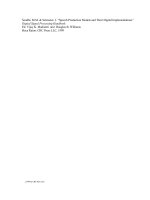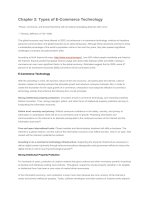Business analytics methods, models and decisions evans analytics2e ppt 13
Bạn đang xem bản rút gọn của tài liệu. Xem và tải ngay bản đầy đủ của tài liệu tại đây (9.82 MB, 76 trang )
Chapter 13
Linear Optimization
Linear Optimization
Optimization is the process of selecting values of
decision variables that minimize or maximize
some quantity of interest.
Optimization models have wide applicability in
operations and supply chains, finance, marketing,
and other disciplines.
This chapter focuses only on linear optimization
models.
Building Linear Optimization Models
1.
2.
3.
4.
Identify the decision variables – the unknown values
that the model seeks to determine.
Identify the objective function – the quantity we seek
to minimize or maximize.
Identify all appropriate constraints – limitations,
requirements, or other restrictions that are imposed on
any solution, either from practical or technological
considerations or by management policy.
Write the objective function and constraints as
mathematical expressions.
Example 13.1 Sklenka Ski Company:
Identifying Model Components
SSC sells two snow ski models - Jordanelle & Deercrest
Manufacturing requires fabrication and finishing.
The fabrication department has 12 skilled workers, each of
whom works 7 hours per day. The finishing department has 3
workers, who also work a 7-hour shift.
Each pair of Jordanelle skis requires 3.5 labor-hours in the
fabricating department and 1 labor-hour in finishing.
The Deercrest model requires 4 labor-hours in fabricating and
1.5 labor-hours in finishing.
The company operates 5 days per week.
SSC makes a net profit of $50 on the Jordanelle model and
$65 on the Deercrest model.
Example 13.1 Continued
Step 1: Identify the decision variables
The company wants to determine how many of
each model should be produced on a daily basis
to maximize net profit.
Define
◦ Jordanelle = number of pairs of Jordanelle skis
produced/day
◦ Deercrest = number of pairs of Deercrest skis
produced/day
Clearly specify the dimensions of the variables!
Example 13.1 Continued
Step 2: Identify the objective function
SSC wishes to maximize net profit, and we are given the
net profit figures for each type of ski.
◦ SSC makes a net profit of $50 on the Jordanelle model and $65
on the Deercrest model.
Example 13.1 Continued
Step 3: Identify the constraints
◦ Look for clues in the problem statement that describe limited resources
that are available, requirements that must be met, or other restrictions.
Both the fabrication and finishing departments have limited
numbers of workers, who work only 7 hours each day; this limits the
amount of production time available in each department:
◦ Fabrication: Total labor hours used in fabrication cannot exceed the amount of
labor hours available.
◦ Finishing: Total labor hours used in finishing cannot exceed the amount of labor
hours available.
The problem also notes that the company anticipates selling at least
twice as many Deercrest models as Jordanelle models:
◦ Number of pairs of Deercrest skis must be at leasttwice the number of parts of
Jordanelle skis.
Negative values of the decision variables cannot occur
(“nonnegativity constraints”)
Translating Model Information into
Mathematical Expressions
Represent decision variables by descriptive
names, abbreviations, or subscripted letters
(X1, X2, etc.)
◦ For mathematical formulations involving many
variables, subscripted letters are often more
convenient.
◦ In spreadsheet models, we recommend using
more descriptive names to make the models and
solutions easier to understand.
Example 13.2: SSC – Modeling the
Objective Function
Profit
per pair of skis sold:
$50 for Jordanelle skis, $65 for Deercrest skis
Objective
Function:
Maximize total profit
= 50 Jordanelle + 65 Deercrest
Note how the dimensions verify that the
expression is correct:
◦ ($/pair of skis)(number of pairs of skis) = $.
Translating Constraints
Mathematically
Constraints are expressed as algebraic inequalities or
equations, with all variables on the left side and constant
terms on the right.
Look for key words in word statements of constraints:
◦ “Cannot exceed” translates mathematically as “≤”
◦ “At least,” would translate as “≥”
◦ “Must contain exactly,” would specify an “= ” relationship.
All constraints in optimization models must be one of
these three forms.
Constraint Functions
A constraint function is the left-hand side of a
constraint.
◦ E.g.: Total labor-hours used in fabrication cannot
exceed the amount of labor hours available.
Example 13.3: SSC – Modeling the
Constraints
Fabrication constraint
Available fabrication labor hours: (12 workers)(7 hours/day) = 84
hours/day
Required fabrication labor hours per ski pair: 3.5 hours for
Jordanelle, 4 hours for Deercrest
Fabrication constraint: 3.5 Jordanelle + 4 Deercrest ≤ 84
Finishing constraint
Available finishing labor hours: (3 workers)(7 hours/day) = 21
hours/day
Required finishing labor hours per ski pair: 1 hour for Jordanelle;
1.5 hours for Deercrest
Finishing constraint: 1 Jordanelle + 1.5 Deercrest ≤ 21
Example 13.3 Continued
Market mixture constraint
◦ The number of pairs of Deercrest skis must be at least
twice the number of Jordanelle skis.
◦ Deercrest ≥ 2 Jordanelle,
◦ or − 2 Jordanelle + 1 Deercrest ≥ 0
Nonnegativity constraints:
◦ Jordanelle ≥ 0
◦ Deercrest ≥ 0
SSC Optimization Model
Maximize total profit = 50 Jordanelle + 65 Deercrest
3.5 Jordanelle + 4 Deercrest ≤ 84
1 Jordanelle + 1.5 Deercrest ≤ 21
−2 Jordanelle + 1 Deercrest
≥0
Jordanelle ≥ 0
Deercrest ≥ 0
The highlighted portions are the constraint functions
More About Constraints
Some examples:
The amount of money spent on research and
development projects cannot exceed the assigned
budget of $300,000.
◦ Amount spent on research and development ≤ 300,000
Contractual requirements specify that at least 500 units
of product must be produced.
◦ Number of units of product produced ≥ 500
A mixture of fertilizer must contain exactly 30% nitrogen.
◦ Amount of nitrogen in mixture/total amount in mixture = 0.30
Example 13.4: Modeling a Mixture
Constraint
A fertilizer mixture is made of two ingredients and must contain exactly
30% nitrogen. Ingredient X contains 20% nitrogen. Ingredient Y
contains 33% nitrogen.
Define x = the number of pounds of X in the mixture and y = the
number of pounds of Y in the mixture
◦ Amount of nitrogen in mixture = 0.20x + 0.33y
◦ Total amount of mixture = x + y
◦ Fraction of nitrogen in mix = (0.20x + 0.33y)/(x + y)
Since the fraction of nitrogen must be 0.30, the constraint
would be
(0.20x + 0.33y)/(x + y) = 0.30, or simplified as -0.1x - 0.03y = 0
Note that the first version is not linear; however the simplified
constraint is linear.
Characteristics of Linear Optimization
Models
A linear optimization model (often called a
linear program, or LP) has two basic properties.
1. The objective function and all constraints are
linear functions of the decision variables.
◦ This means that each function is simply a sum of terms,
each of which is some constant multiplied by a decision
variable.
2.
All variables are continuous
◦ This means that they may assume any real value
(typically, nonnegative).
Implementing Linear Optimization
Models on Spreadsheets
Put the objective function coefficients, constraint coefficients, and
right-hand values in a logical format in the spreadsheet.
◦ For example, you might assign the decision variables to columns and the
constraints to rows
Define a set of cells (either rows or columns) for the values of the
decision variables.
◦ The names of the decision variables should be listed directly above the
decision variable cells.
◦ Use shading or other formatting to distinguish these cells.
Define separate cells for the objective function and each constraint
function (the left-hand side of a constraint).
◦ Use descriptive labels directly above these cells.
Example 13.5: A Spreadsheet Model for
Sklenka Skis
Decision variables Objective function Constraint functions
Correspondence Between the Model and
the Spreadsheet
Maximize Jordanelle + 65 Deercrest
3.5 Jordanelle + 4 Deercrest ≤ 84
1 Jordanelle + 1.5 Deercrest ≤ 21
−2 Jordanelle + 1 Deercrest ≥ 0
Jordanelle ≥ 0
Deercrest ≥ 0
Maximize D22 = B9* B14 + C9* C14
D15 = B6* B14 + C6* C14 ≤ D6
D16 = B7* B14 + C7* C14 ≤ D7
D19 = C14 - 2* B14 ≥ 0
B14 ≥ 0
C14 ≥ 0
Using the SUMPRODUCT Function
In Excel, the pairwise sum of products of terms
can easily be computed using the SUMPRODUCT
function.
◦ B9* B14 + C9*C14 = SUMPRODUCT(B9:C9,B14:C14)
This often simplifies the model-building process,
particularly when many variables are involved.
Excel Functions to Avoid in Linear
Optimization
Several common functions in Excel can cause difficulties
when attempting to solve linear programs using Solver
because they are discontinuous (or “nonsmooth”) and do
not satisfy the conditions of a linear model.
These include:
◦
◦
◦
◦
◦
IF
MAX
INT
ROUND
COUNT
Solving Linear Optimization Models
A feasible solution to an optimization problem is
any solution that satisfies all of the constraints.
An optimal solution is the best of all the feasible
solutions.
Software for determining optimal solutions
◦ Solver (“standard Solver”) is a free add-in packaged with
Excel for solving optimization problems.
◦ Premium Solver, which is a part of Analytic Solver
Platform has better functionality, accuracy, reporting, and
interface.
Using the Standard Solver
Data > Analysis > Solver in the Excel ribbon
Use the Solver Parameters dialog to define the
objective, decision variables, and constraints from
your spreadsheet model.
Example 13.6: Using Standard Solver for
the SSC Problem
Solver Parameters dialog
Objective function cell
Decision variables cells
Constraints
to enter click Add and fill in the Add
Constraint dialog:
Check box for Nonnegativity
Always select “Simplex LP”









